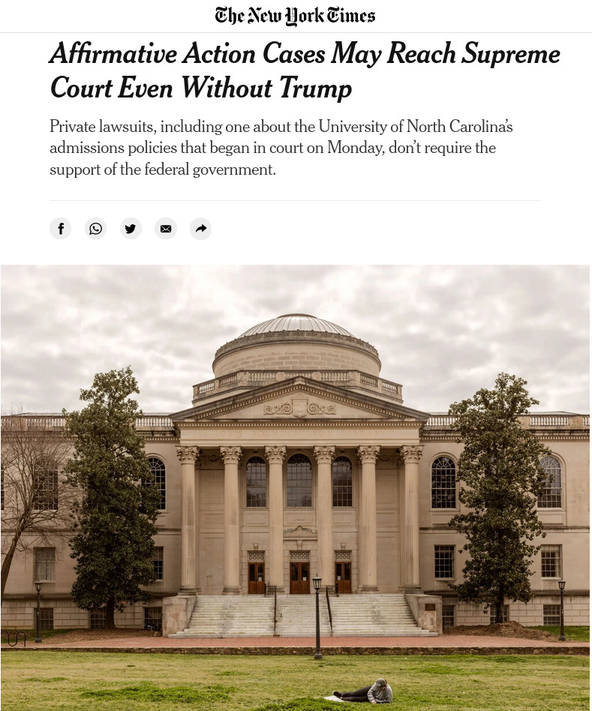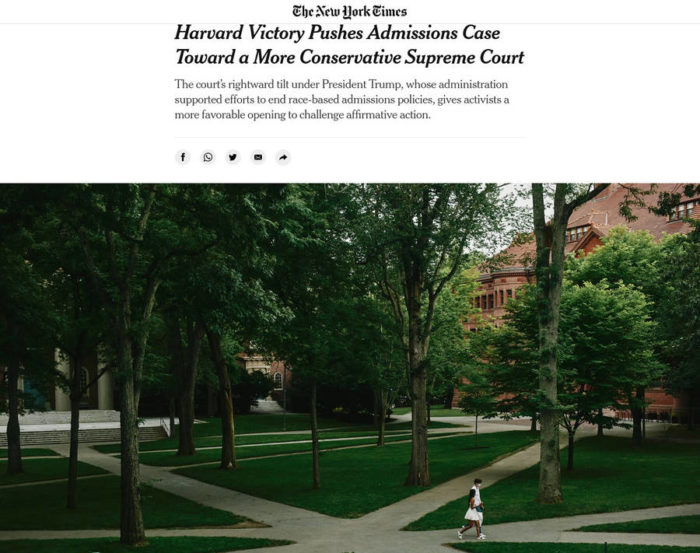How a Nation With No Racists Can Appear Half-Racist to Everyone in It
Recent New York Times stories, Harvard Victory Pushes Admissions Case Toward a More Conservative Supreme Court and Affirmative Action Cases May Reach Supreme Court Even Without Trump, both by Anemona Hartocollis, lay bare a national divide.

[Note: You may notice the “recent” stories are from last year. I wrote this post soon after the articles but held back on posting it. I keep reading about well-meaning people apparently deliberately misunderstood and attacked for talking about race. In the end, I decided not to be imprisoned by my fears. I can’t see how the following could be misunderstood to sound anything but helpful, but others felt that way about their communications. I think you’ll like it.]
Many on the left, supporting “race-based admissions policies that have helped diversify the student bodies of prestigious public and private universities” call the right racist. Many on the right, suggesting that “elite institutions have been ‘fostering stereotypes, bitterness and division among the American people’ by dividing them into racial groups” call the left racist.
Both acknowledge racism as a problem that they view themselves as solving. How can this be? Is one half right and the other wrong? Could that many people be racist without realizing it?
What if we misunderstood the whole situation? Could nearly no one be racist? I’ll show how it’s possible. Understanding how can improve our democracy, calm us, and point a way forward.
It starts with a basic leadership concept of mental models—lenses that color our perception, leading us to see the same thing differently. Not good or bad, they’re how our minds simplify more information than they can process. Few realize how deep or pervasive their effects.
Consider an example. Say you grew up with a pit bull as a pet and I was once bitten by one. You might see them as cuddly. I might see them as dangerous. In a room with one, you might approach it calmly. Sensing your calm, it might respond friendly. I might back away anxiously, prompting it to growl. Confirmation and other biases lead us both to feel right despite opposite mental models of the same dog.
Those who don’t understand mental models don’t think they believe them. They just think they’re right, unaware others’ models differ. We think the dog is that way, not that we have models: “If you disagree, you don’t have a problem with me, you have a problem with reality.â€

Another example: When lockdowns began, I looked for mental models for this new experience and thought of two. Nelson Mandela was, in a sense, locked down for twenty-seven years. 600 million people participated in his seventieth birthday and he emerged to become president. Viktor Frankl was more than locked down by Nazis in Auschwitz and emerged to write of bliss, love, and creating meaning—that “everything can be taken from a man but one thing: the last of the human freedoms—to choose one’s attitude in any given set of circumstances, to choose one’s own way.†I did so, helping create meaning for my experience.
Two Models
Consider two other models I’ll show relevant to race. First: if while driving you find you’ve drifted from the lane and two wheels are off the road. You’d conclude you steered wrong and steer the other way to get back on the road. You’d consider someone suggesting staying off course foolish, even dangerous, risking ruining or flipping the car. Lives are at stake.
Second: Imagine you were an anesthesiologist who accidentally underdoses a patient. You wouldn’t administer too much the next time to even things out. You’d return to giving the optimal dose. Giving extra risks killing the patient. A life is at stake.
Few disagree that America has racism in its past that persists today. Through what lenses do we see it? What if some see it like our wheels are off the road while others like we gave wrong amount of medicine?
Consider college acceptance. Say that everyone agrees that racism led to some groups having to work harder to attain equal grades. People believing the car-off-the-road model may see an obvious and natural solution to consider race—as the articles quoted one university official, “a factor to be considered along with so many other things, [including] obstacles overcome.†In their model, they’re steering the car back on the road.
People believing the medicine model may see an equally natural solution to remove unequal treatment by treating everyone equally now—as the articles quoted a conservative strategist, to “end all considerations of race in college admissions.†In their model, they’re not overdosing or underdosing. They’re properly dosing.
The first group sees ignoring race as perpetuating racism. The second group sees involving race as perpetuating it. Both groups believe themselves solving the problem and the other exacerbating it, ignorant, and racist. Both believe “If you disagree with me, you don’t have a problem with me, you have a problem with reality.â€
Racists exist. Not everyone believes the above models, but we all view the world through models that unexpectedly conflict. A nation with only people intending to end racism can appear to all as half racist.
Can we resolve this problem? Can we know if one model would solve a given problem better? Maybe one would in some situations and another in others. Maybe both would work, or neither. In principle science could tell, but with many confounding variables and no spare universe to run a control, not in practice.
Resolution
But the story continues, offering hope. Realizing that we see the world through models may not resolve disagreement, but it replaces anger at others’ apparent idiocy with curiosity to learn their models. Learning another person’s model doesn’t mean we have to agree, but we can still support others as people equally liable to confuse model with reality and confirmation bias with proof.
We never know whose solution would have worked best, only what happened. Still, understanding how models work allows us to accept, even celebrate, our nation’s strategy to live together amid conflicting models: democracy. Elections may go with us some times and against us others. but understanding how models work replaces anger, lecture, and self-righteousness with curiosity, questions, and humility, which we can all use more of.
Read my weekly newsletter

On initiative, leadership, the environment, and burpees
3 responses on “How a Nation With No Racists Can Appear Half-Racist to Everyone in It”